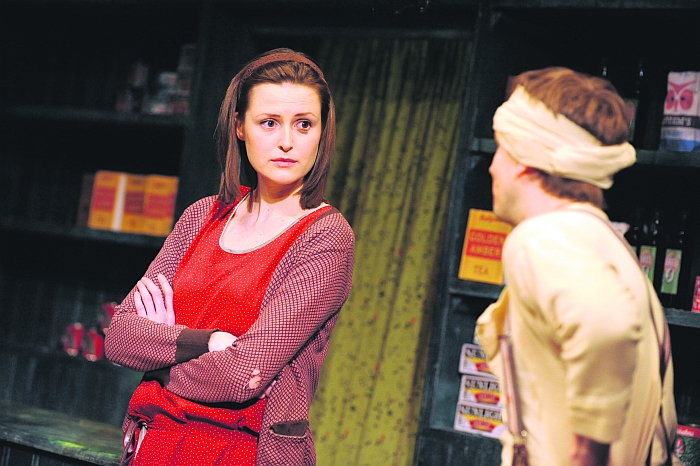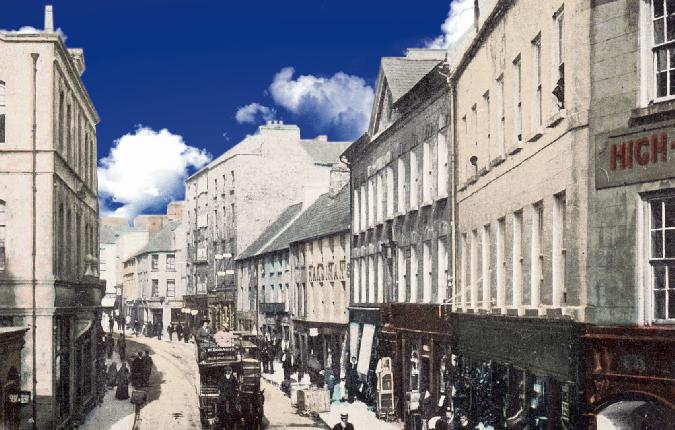Archive News
Actress Clare makes waves as Druid sets sail for Inis Me‡in

Date Published: {J}
It’s 3.30pm Irish time and it’s 10.30am in Charleston, South Carolina where actress Clare Dunne is having a well-earned morning rest.
The previous day she performed in two showings of Martin McDonagh’s play, The Cripple of Inshmaan with Druid Theatre Company, as part of a major tour of America.
Clare is playing Slippy Helen in The Cripple which began its American tour in February and will wrap up the visit with a trip in New Haven on June 19.
Then the play – which was inspired by Robert O’Flaherty’s visit to Aran in 1934 to make the famous film Man of Aran – returns to Ireland, where its destinations include Galway city and Inis Meáin.
The Inis Meáin visit marks the final stop on the company’s five-month tour of the dark comedy with its central character of Cripple Billy, a disabled boy whose aim in life is to reach Inis Mór and take part in O’Flaherty’s film.
As is common in McDonagh’s plays, there is a cast of comic characters, including local gossip Johnny Pateen Mike, and of course Slippy Helen, the sadistic girl next door who torments Billy when she isn’t ‘pegging eggs’ at people who annoy her.
These characters are capable of seemingly meaningless acts of small cruelty, which is what gives McDonagh’s work such an edge.
The Cripple of Inishmaan is Clare’s third play with Druid – not a bad achievement given that the Dublin actress has only been working professionally for two years, since graduating from the Welsh College of Music and Drama in Cardiff.
“Druid gave me my professional debut, she says, explaining that the company’s casting director Maureen Hughes auditioned her in 2009 and immediately said “you’d be a great Pegeen Mike”.
Druid’s Artistic Director Garry Hynes agreed, casting her in a revival of The Playboy of the Western World after hearing Clare read the role for a few minutes. Straight out of college, Clare appeared in Playboy, touring Ireland and the UK in 2009
Taking on such a major role with a company of Druid’s stature might have been daunting, especially since the rehearsal period was very short, but it was also a great opportunity for Clare.
“It was a bit mental,” she laughs.”I didn’t have an agent then, but I got one out of that.”
And although she has had short periods of unemployment for a few months here and there since, she has also worked with Druid on The Silver Tassie (playing Susie Monican) as well as with the Lyric Theatre in Hammersmith, London on several productions including Chekov’s The Three Sisters and Shakespeare’s A Midsummer Night’s Dream.
For more, read this week’s Connacht Tribune.
Galway in Days Gone By
The way we were – Protecting archives of our past

People’s living conditions less than 100 years ago were frightening. We have come a long way. We talk about water charges today, but back then the local District Councils were erecting pumps for local communities and the lovely town of Mountbellew, according to Council minutes, had open sewers,” says Galway County Council archivist Patria McWalter.
Patria believes we “need to take pride in our history, and we should take the same pride in our historical records as we do in our built heritage”. When you see the wealth of material in her care, this belief makes sense.
She is in charge of caring for the rich collection of administrative records owned by Galway County Council and says “these records are as much part of our history as the Rock of Cashel is. They document our lives and our ancestors’ lives. And nobody can plan for the future unless you learn from the past, what worked and what didn’t”.
Archivists and librarians are often unfairly regarded as being dry, academic types, but that’s certainly not true of Patria. Her enthusiasm is infectious as she turns the pages of several minute books from Galway’s Rural District Councils, all of them at least 100 years old.
Part of her role involved cataloguing all the records of the Councils – Ballinasloe, Clifden, Galway, Gort, Loughrea, Mountbellew, Portumna and Tuam. These records mostly consisted of minutes of various meetings.
When she was cataloguing them she realised their worth to local historians and researchers, so she decided to compile a guide to their content. The result is For the Record: The Archives of Galway’s Rural District Councils, which will be a valuable asset to anybody with an interest in history.
Many representatives on these Councils were local personalities and several were arrested during the political upheaval of the era, she explains.
And, ushering in a new era in history, women were allowed to sit on these Rural District Councils – at the time they were not allowed to sit on County Councils.
All of this information is included in Patria’s introductory essay to the attractively produced A4 size guide, which gives a glimpse into how these Rural Councils operated and the way political thinking changed in Ireland during a short 26-year period. In the early 1900s, these Councils supported Home Rule, but by 1920, they were calling for full independence and refusing to recognise the British administration.
“I love the tone,” says Patria of the minutes from meetings. “The language was very emotive.”
That was certainly true of the Gort Rural District Council. At a meeting in 1907, following riots in Dublin at the premiere of JM Synge’s play, The Playboy of the Western World the councillors’ response was vehement. They recorded their decision to “protest most emphatically against the libellous comedy, The Playboy of the Western World, that was belched forth during the past week in the Abbey Theatre, Dublin, under the fostering care of Lady Gregory and Mr Yeats. We congratulate the good people of Dublin in howling down the gross buffoonery and immoral suggestions that are scattered throughout this scandalous performance.
For more from the archives see this week’s Tribunes here
Archive News
Galway have lot to ponder in poor show

Date Published: 23-Jan-2013
SLIGO 0-9
GALWAY 1-4
FRANK FARRAGHER IN ENNISCRONE
GALWAY’S first serious examination of the 2013 season rather disturbingly ended with a rating well below the 40% pass mark at the idyllic, if rather Siberian, seaside setting of Enniscrone on Sunday last.
The defeat cost Galway a place in the FBD League Final against Leitrim and also put a fair dent on their confidence shield for the bigger tests that lie ahead in February.
There was no fluke element in this success by an understrength Sligo side and by the time Leitrim referee, Frank Flynn, sounded the final whistle, there wasn’t a perished soul in the crowd of about 500 who could question the justice of the outcome.
It is only pre-season and last Sunday’s blast of dry polar winds did remind everyone that this is far from summer football, but make no mistake about it, the match did lay down some very worrying markers for Galway following a couple of victories over below par third level college teams.
Galway did start the game quite positively, leading by four points at the end of a first quarter when they missed as much more, but when Sligo stepped up the tempo of the game in the 10 minutes before half-time, the maroon resistance crumbled with frightening rapidity.
Some of the statistics of the match make for grim perusal. Over the course of the hour, Galway only scored two points from play and they went through a 52 minute period of the match, without raising a white flag – admittedly a late rally did bring them close to a draw but that would have been very rough justice on Sligo.
Sligo were backable at 9/4 coming into this match, the odds being stretched with the ‘missing list’ on Kevin Walsh’s team sheet – Adrian Marren, Stephen Coen, Tony Taylor, Ross Donovan, David Kelly, David Maye, Johnny Davey and Eamon O’Hara, were all marked absent for a variety of reasons.
Walsh has his Sligo side well schooled in the high intensity, close quarters type of football, and the harder Galway tried to go through the short game channels, the more the home side bottled them up.
Galway badly needed to find some variety in their attacking strategy and maybe there is a lot to be said for the traditional Meath style of giving long, quick ball to a full forward line with a big target man on the edge of the square – given Paul Conroy’s prowess close to goal last season, maybe it is time to ‘settle’ on a few basics.
Defensively, Galway were reasonably solid with Gary Sice at centre back probably their best player – he was one of the few men in maroon to deliver decent long ball deep into the attacking zone – while Finian Hanley, Conor Costello and Gary O’Donnell also kept things tight.
For more, read this week’s Connacht Tribune.
Archive News
Real Galway flavour to intermediate club hurling battle in Birr

Date Published: 23-Jan-2013
images/files/images/x3_Courthouse.jpg










